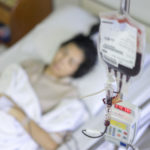Sickle cell disease, gene therapy, and blood cancers: Mysteries remain

Gene therapy trials for sickle cell disease have been showing great promise, even offering hope of a cure. But in early 2021, the trials ground to a halt after reports of blood malignancies in two people in a trial sponsored by bluebird bio. Investigations later concluded that the gene therapy delivery vectors were likely not to blame, and the trials resumed, including one at Dana-Farber/Boston Children’s Cancer and Blood Disorders Center. But the mystery remains: Why did these malignancies occur? And should they deter people with sickle cell disease from entering gene therapy trials? That is the subject of a growing body of research.
“As a hematologist, I’m tremendously excited by gene therapy and the prospect of curative treatments for my patients,’” says Vijay Sankaran, MD, PhD, an attending physician at Dana-Farber/Boston Children’s. “But for patients, cancer risk is a worry.”
Clonal hematopoiesis in sickle cell disease?
Some experts suggests that people with sickle cell disease may have an elevated risk for blood malignancies in general, especially as they get older. However, the cases reported in the gene therapy trials seemed to go beyond the expected “background” rate. In a recent study in the Journal of Clinical Investigation, Sankaran’s lab, led by postdoctoral fellow Alex Liggett, PhD, explored one possible explanation: a potentially pre-leukemic condition called clonal hematopoiesis.
In clonal hematopoiesis, people acquire mutations causing some of their blood stem cells to multiply faster than others, forming distinct populations or “clones.”
“Clonal hematopoiesis can increase the risk of blood cancers by up to 10-fold,” says Sankaran. “It’s been speculated that people with sickle cell disease may have a higher rate of clonal hematopoiesis, and that we should consider screening patients for it before enrolling them in gene therapy trials — or even if they aren’t getting gene therapy.”
Investigating clonal hematopoiesis
The study analyzed whole-genome sequencing data from more than 3,000 people with sickle cell disease and more than 71,000 people without the disease, looking for somatic mutations and clonal blood cell populations.
Somewhat surprisingly, the rate of clonal hematopoiesis in people with sickle cell disease was no greater than that in the general population. “This tells us that monitoring patients with sickle cell disease for clonal hematopoiesis, at least at levels we can detect with whole genome sequencing, is not going help us figure out the basis for the elevated cancer risk,” says Sankaran.
As people live longer with sickle cell disease, we have to be more aware of the long-term cancer risk.”
David A. Williams, MD, chief of Hematology/Oncology at Boston Children’s, was instrumental in launching the current sickle cell gene therapy trial at Boston Children’s and was coauthor on the study.
“These new data contribute significantly to the ongoing discussions about leukemia risk in individuals with sickle cell disease,” he says. “It is critical that the field understands this risk more completely so we can improve the safety of our gene therapy approaches for these patients.”
Beyond gene therapy: Exploring cancer risk in sickle cell disease
Sankaran notes that the study was unable to detect small clonal populations involving rare mutations. That’s next on the agenda to explore as part of a large collaborative effort through the National Heart, Lung, and Blood Institute’s Cure Sickle Cell initiative.
“Rare clones may arise as a result of the way cells are handled or processed in gene therapy,” Sankaran says. “Or maybe something about the conditioning regimens used prior to gene therapy selects for rare clones. Until we study this, we won’t know. Gene therapy is still experimental, and there are probably things we’re going to learn.”
Williams and Erica Esrick, MD, principal investigator on Boston Children’s gene therapy trial, are now collaborating with investigators in the United Kingdom to study the effects of cell processing on the possible development of mutations in gene therapy recipients.
But separate from gene therapy, the study leaves many questions about cancer risk in people with sickle cell disease, especially those living well into adulthood. Their risk of myeloid blood cancers has not been well studied, but is believed to be five- to 10-fold higher than that in the general population. That risk is potentially as high as in patients with recognized leukemia predisposition syndromes, including many bone marrow failure disorders.
Much remains unclear. In the future, as we learn more, clinicians could counsel patients as part of the Pediatric Cancer Genetic Risk Program at Dana-Farber/Boston Children’s. “As people live longer with sickle cell disease, we have to be more aware of the long-term cancer risk,” says Sankaran. “We need to learn more about these malignancies and start discussing this risk.”
Learn more about how our Gene Therapy Program treats patients with sickle cell disease
Related Posts :
-

Gene therapy to boost fetal hemoglobin continues to do well in sickle cell trial
A pilot gene therapy treatment for sickle cell disease, restoring patients’ ability to make fetal hemoglobin, has produced good results ...
-

A big step toward curbing graft-vs.-host disease after bone marrow transplant
A drug used for rheumatoid arthritis has moved a step closer to FDA approval for a desperately needed new use. ...
-

After decades of evolution, gene therapy arrives
As early as the 1960s, scientists speculated that DNA sequences could be introduced into patients’ cells to cure genetic disorders. ...
-

Preventing leukemia by preventing rogue blood cells from taking over
As we age, many of us acquire mutations that cause some of our blood stem cells to multiply faster than ...





